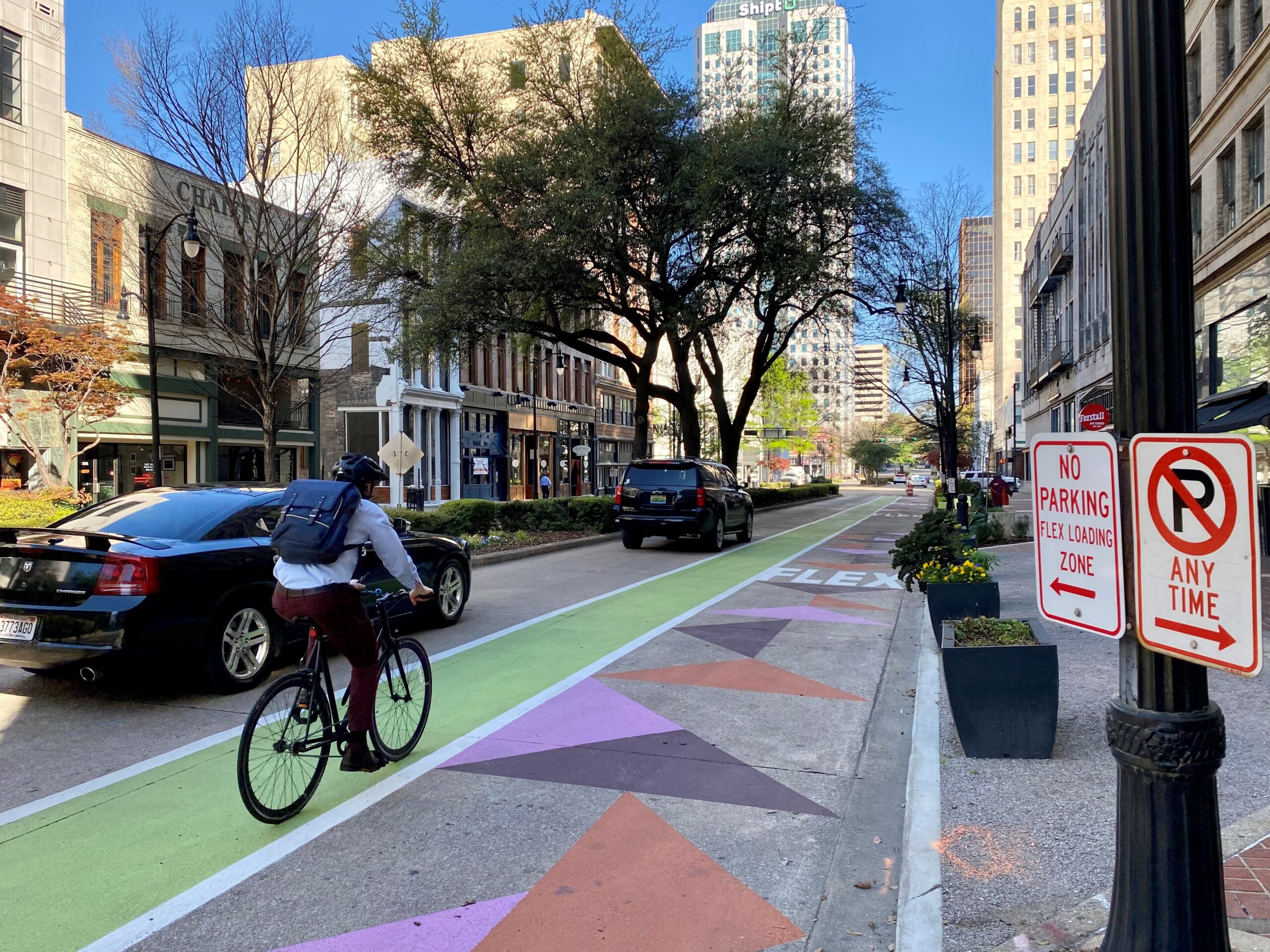
Flex lane paint is down on two blocks of 20th Street North, and we’re already hearing your celebration, thoughtful feedback, and a few questions!
If you haven’t seen the new look yet in person, plan a stroll soon down the Birmingham Green, then take our survey to tell us what you think about the usability and design of the flex lanes.
As we’ve been reviewing survey responses (yes, we’re reading them and taking it all in!), we’ve encountered several good questions, so we decided to address them in a short video tour. Take a look!
This design is based on national best practices and follows the direction of multiple City of Birmingham planning efforts, including the City Center Master Plan (2019), APPLE Study (2018), the Regional Planning Commission’s B Active Plan, and Birmingham’s Complete Streets Ordinance . All recognize a need for a safer and more multimodal downtown, especially along pedestrian corridors like 20th Street North.
The new design on 20th Street…
- creates a buffer from traffic for pedestrians on the sidewalk
- adapts to business needs like curbside food pickup, valet stands, and more creative uses
- gives bikes, scooters and other micromobility devices a well-defined space to travel in
- reduces the width of the travel lane, which is proven to reduce speeding, without changing the road’s capacity (meaning 20th can hold the same number of vehicles, but now they’re more likely to observe the speed limit)
Why is the bike lane in the middle?
Bike lanes that are separated from car traffic with parking space are awesome, but this flex lane is not parking. In addition to pick-up and loading/unloading, we expect more creative uses that will make the flex lane more like an extension of the sidewalk than a part of the road.
The bike lane’s position in the middle (rather than against the curb) also increases visibility between cyclists and drivers. Drivers turning right can easily spot cyclists, and cyclists making left turns can more easily merge left. The green of the bike lane is a standard color that drivers will see on bike lanes all over the country.
Where’s the bus stop?
Good catch – we moved it from a location where passengers had to board from a flower bed to the other side of the street where the bus can be boarded from the sidewalk! The bus stop is marked in red, which is the universal traffic paint color for public transportation.
Why those colors and shapes in the flex lane?
The flex lane is a bold new concept, so it needs a bold new design. The colors signal that this lane is different than normal parking or travel lanes. Plus, the colors can’t conflict with other traffic markings. Green bike lane, red bus stop, white and yellow lane striping: many colors have defined meanings on roadways. So the funky colors in the flex lanes are different by design.
The geometric pattern has a similar story. Alabama law prevents us from using a design that contains a representation of a real object, so no pictures or icons. Some geometric shapes and patterns are already spoken for as well, like the stripes of a crosswalk.
The design of the flex lane represents a new way of looking at streets in Birmingham. We’ve already seen that they can do so much more than host cars! While this exact design is specific to 20th Street, we look forward to testing it out here and applying the best concepts across the city to increase safety and vibrancy all over Birmingham. Can we get a #YayBham? 🙌
Related News
-
Why we say yay to two-way streets
Filed Under: Developer, Downtown Birmingham, Filling Vacant Spaces, Front Page, Transportation, Yaysayers
REV Birmingham is a long-time advocate for making the switch to two-way streets downtown, and this is something recommended by planners studying our downtown for years. In fact, the team that developed the 2004 City Center Master Plan recommended many street changes but noted 4th Avenue North conversion should take place “immediately.” We believe this project is a catalytic moment for Birmingham – but you may find yourself wondering why that is.
-
The Key Tool for Urban Revitalization: Downtown BHM's Business Improvement District
Filed Under: Business-Proving, Developer, Downtown Birmingham, Front Page, Get Involved, Potential-Proving, Why BHM
By the time REV took on BID management in 2018, downtown had a new set of needs from its BID. Downtown Birmingham in the ‘90s had a population mainly of 9 to 5 employees. But the downtown of 2018 had a whole new population of residents and visitors throughout the day and night. We had new opportunities to create positive experiences, inviting them into more downtown businesses and public spaces, and to keep them coming back for more.
-
Introducing the six businesses that call Nextec home
Filed Under: Business-Proving, Developer, Downtown Birmingham, Filling Vacant Spaces, Front Page, Historic Preservation, Potential-Proving, Why BHM
On the corner of 3rd Avenue and 16th Street North, you’ll find Nextec, a redevelopment of the 90-year-old, 65,000-square-foot Edwards Motor Company building (also formerly known as the Sticks ‘N’ Stuff building). With experience in historic renovation, developer Michael Mouron, chairman of Capstone Real Estate Investments, began this civic project in 2021 as a space for business startups to continue their work in the Magic City – a function encouraged by REV Birmingham.